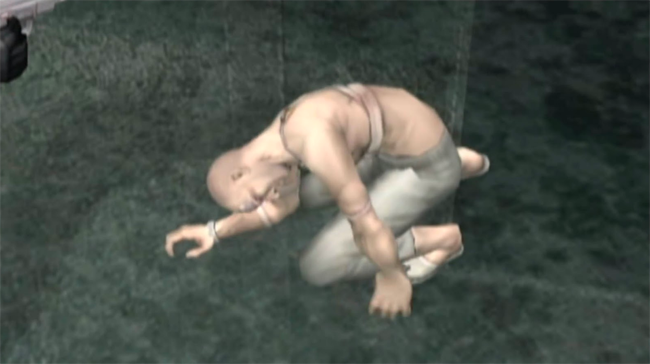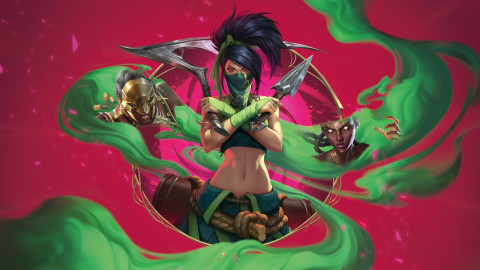
Warning: Spoilers for Hellblade: Senua’s Sacrifice and several other older games to follow!
On Tuesday, Ninja Theory released its latest game, Hellblade: Senua’s Sacrifice, to great reviews from both the general public and critics. The game blurs the line between psychological horror and fantasy by focusing on a protagonist suffering from severe psychosis, which causes delusions and effectively makes her an “unreliable narrator.” Hellblade’s use of visual effects, changing environments, and constant voices in Senua’s head cause us to, at least to some degree, feel as confused and anxious as she is, but one particular game mechanic attracted most of the attention on release day.
After about fifteen minutes of exploring the twisted underworld of Hel, Senua comes across a group of enemies, which strike her down before her journey even has a chance to start. Discovering her own “dead” body, Senua notices that there’s a rot made of pure darkness moving up her arm. It’s here that Hellblade warns players against repeated failure. Die too many times and have the rot reach her face, and you’ll be forced to restart the entire adventure again – at around eight hours, this would be a monumental time-sink for those who fail near the end of the game. For the entirety of the game, that thought weighs over your head. What if I mess up on this fight? Just how many more chances will I have before I reach the limit?
As it turns out, that line of thinking cannot go beyond worrying in Hellblade, because it’s impossible to reach that limit. The mechanic is introduced early in the game for the sole purpose of increasing your worry – to further increase your own nervousness. Whether or not this was completely effective is certainly subjective, but it didn’t take long for players to experiment and determine that the “permadeath” feature is fake. Seeing this before playing the game will ruin the surprise (hence the spoiler warning) but learning that I, and every other critic, had been bamboozled, put a wonderful bow on an already unique game. Of course, Hellblade isn’t alone in its clever trickery. Here are a few of our favorite tricks ever pulled by game developers, from narrative twists to perspective shifts.
Castlevania: Lords of Shadow

The Castlevania series has used the same basic premise for its entire existence: vampire hunters versus Dracula. For the most part, the heroes have been members of the Belmont family, devoted to protecting their home from Dracula and his minions even as townspeople mock them for their belief in the supernatural. But Castlevania: Lords of Shadow was different. Effectively a reboot of the series, MercurySteam’s game starred a new Belmont named Gabriel, and its story didn’t concern Dracula at all. Instead, Gabriel spent the majority of his time searching for a way to resurrect his deceased wife with the aid of a mysterious man named Zobek.
As the lengthy game reached his conclusion, we finally learned of the real villain responsible for much of its events: Satan himself. Defeating him but with no way to actually bring his wife back to life, Gabriel’s ending is bittersweet.
But the twist was yet to come. After sitting through the game’s credits, a cinematic taking place in modern-day Europe revealed that Dracula was technically in Lords of Shadow since the beginning, because Gabriel would eventually become a vampire and adopt the name. It set the stage for a much-anticipated sequel that would finally allow us to use Dracula’s vampire powers, and though Lords of Shadow 2 didn’t live up to expectations, Gabriel’s famous “Eu sunt Dracul” line still gives us chills.
Second Sight

A little-known game developed by TimeSplitters studio Free Radical Design, Second Sight was, ostensibly, a game told in flashback sequences. Dr. John Vattic, a research scientist, has been radically transformed following an experiment, left with telekinetic powers and very little recollection of who he was or why he was being held against his will. Gradually, his memory begins to return, and he remembers his time as a scientist in Russia, which ultimately led to his newfound abilities.
Or so he believed. John eventually discovers that the “flashbacks” he had been experiencing weren’t actually from the past at all. Instead, they took place in a possible future, which he had the ability to see. Nearly every horrific thing he had witnessed, including the forced institutionalization of one of his coworkers, could still be stopped, provided that he used his newly discovered ability to change the future.
It was a trick that, unfortunately for Free Radical, could only really be used once. Second Sight didn’t exactly light up the sales charts, which the studio claimed was its rationale behind not making a sequel, but any attempt to build on that specific psychological thriller formula wouldn’t be as successful – players would be expecting the game to trick them in some form, even if it didn’t make use of the same narrative device.
Halo 2

The Master Chief had been the only character fans had controlled in the original Halo: Combat Evolved game, and all signs pointed to this also being the case in Halo 2. After all, with the Covenant arriving to Earth, Bungie was setting the stage for enormous battles that saw Spartan-117 and his UNSC allies fend off waves of aliens, all while trying to preserve what remained of the planet. Rarely had there been an enemy in video games so hell-bent on humanity’s destruction, and the vicious, intelligent “Elite” race were among the most terrifying in the Covenant ranks.
Imagine our surprise when midway through the game, Halo 2 took the focus off of the Master Chief and shifted it to a disgraced Elite warrior known as the Arbiter. For about half of the game, we learn about the internal power struggles within the Covenant, as well as the racism and religious idolatry that turned the alien army into an irrational and destructive force determined to not only destroy humanity, but also itself.
The Halo series has used this perspective-switching technique again in subsequent installments. The Arbiter appears again in Halo 3, and after a Master Chief-only adventure in Halo 4, much of Halo 5 is from the perspective of newcomer Jameson Locke. This design choice has lost some of its luster over the years, but we’ll never forget stepping into the boots of the Arbiter for the first time.
Metal Gear Solid V: The Phantom Pain

Yes, the bait-and-switch in Metal Gear Solid 2 was an impressive twist. Playing as Raiden instead of series star Solid Snake certainly threw fans for a loop, and some of them still haven’t let Hideo Kojima live it down in the following years. But 2015’s Metal Gear Solid V: The Phantom Pain included a twist so monumental, that it not only changed how we viewed the game, but the series as a whole.
The game’s prologue, Metal Gear Solid V: Ground Zeroes, stars Naked Snake – known as “Big Boss” by this point – in a covert operation that ultimately ends with disastrous results. Injured in a helicopter crash, Big Boss is placed in a coma, where he remains for several years. It isn’t until he’s rescued by a bandaged man named “Ishmael” that his mission begins. Building up a massive sovereign mercenary army, Big Boss works to stop the bioterrorist Skull Face, who plans to end nations’ conflict by relying on an extreme form of “Mutually Assured Destruction.”
After suffering personal tragedy and seeing many of his men killed and his own psyche destroyed, Big Boss eventually discovers the truth: He isn’t Big Boss at all, but a medic also present during the Ground Zeroes mission -- the real Big Boss was Ishmael, who was able to continue his own work uninterrupted while the imposter built up his “Diamond Dogs” army. Brainwashed to believe he was the real Big Boss, “Venom Snake” even underwent plastic surgeries to make himself look virtually identical. It’s this character who confronts Solid Snake in the original Metal Gear game, and it explains Big Boss’ peculiar reappearance in the sequel after his supposed death.

Disclaimer : The following article was written freely based on the author's opinion, and it may not necessarily represent Inven Global's editorial stance.
Sort by:
Comments :0






